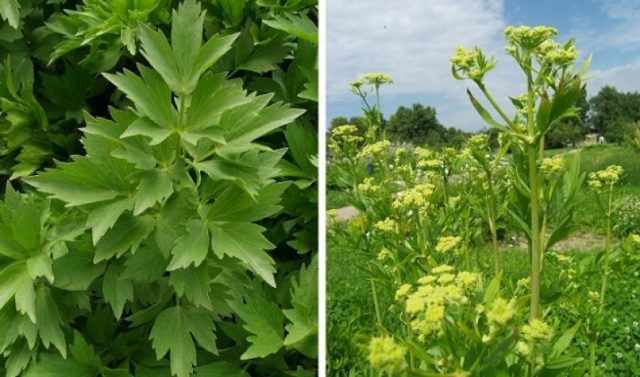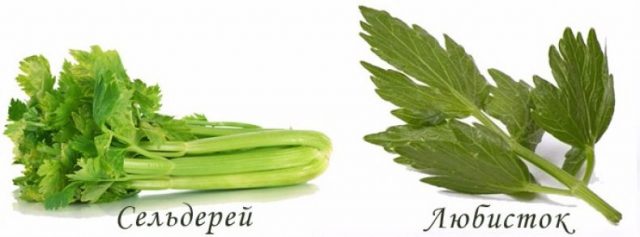Content
Among the many garden crops, the umbrella family is probably the richest in its representatives. This is parsley, and parsnips, and celery, and carrots, and lovage. Some of these crops are well known even to children, while others can only be recognized by experienced gardeners. Moreover, many are even almost sure that lovage and celery are one and the same plant, only under different names, these herbs are so similar in taste and aroma in appearance.
Lovage and celery are the same thing or not
Usually, many people get acquainted with celery first, since this culture is more common and popular, even despite its relative whimsical cultivation. Celery has three varieties: root, petiole and leaf. In the first variety, a large underground rounded root crop is formed, up to 15-20 cm in diameter. The second variety is characterized by thick juicy petioles, usually very delicate in taste and with large leaves. And leaf celery has small petioles and small leaves.
Celery has been known since ancient times. Even the ancient Greeks and Romans highly appreciated this spicy-flavoring culture and used celery not only for food, but also for medicinal purposes. It came to Russia only at the beginning of the 18th century and at the moment has spread everywhere.
While lovage has been known on the territory of Russia since antiquity. It was believed that lovage growing in the garden brings happiness. And the girls used this plant to bewitch future husbands. Due to its popularity, this herb has many popular names: love-grass, dawn, love parsley, sweetheart, lover, piper.
Lovage does indeed strongly resemble celery, especially at a young age, before flowering. They have very similar leaves, pinnately dissected, shiny, on rather long petioles. But these two plants, despite some external similarity, belong to different botanical genera and have quite a few differences.
How celery differs from lovage
Celery, unlike lovage, is a spicy vegetable, not just a fragrant herb. It is not only added to various dishes to give them additional aroma and taste, but they are also used to prepare completely independent dishes from it.
In celery, absolutely all parts of the plant are actively used in cooking: rhizomes, stems, leaves, flowers and seeds.
The plants usually grow in height from 60 cm to 1 m. The color of the leaves is green, saturated, but lighter in comparison with lovage. The root leaves of celery are different from those that form on the stem. They have more pronounced fleshy petioles (especially in the petiolate variety), and the leaf blades have long, sharp teeth.
The resulting inflorescences are small, have a greenish, sometimes whitish, not too attractive shade. Seeds are very small in size, brownish-brown in color, and have no villi.
Celery plants are biennial in nature. In the first year, they form a green deciduous mass and a bulky rhizome (in the case of the rhizome variety of celery). In the second year of life, the plants throw out a peduncle, form seeds and die.
Unlike other members of the umbrella family with a similar life cycle (parsley, carrots), celery has a very long growing season. Especially in rhizome varieties. In order for a rhizome of normal size to form, it can take up to 200 or more days. Therefore, in most regions of Russia, it makes sense to grow rhizome celery exclusively through seedlings.
In addition, this vegetable is distinguished by its tenderness, capriciousness and whimsical cultivation. Young plants practically do not tolerate frost, therefore, celery seedlings can be planted in open ground only at a time when the threat of frost can be almost completely said goodbye. In most regions of Russia, this date does not come earlier than the end of May or the beginning of June.
Celery has a rather delicate and spicy taste and aroma that is attractive to many. The aftertaste has no bitterness.
How to tell lovage from celery
Of course, if you look at the cut bunches of celery and lovage that are sold on the market, even an experienced gardener will not immediately distinguish them from each other. You can only notice that the leaves of lovage are darker than those of celery, and the petioles do not look so fleshy. Although the leaves from the top of the celery bushes practically do not differ from lovage. And their aroma is almost identical.
Otherwise, lovage has a lot of features that are unique to it.
- First of all, it is a perennial plant that easily propagates both by seeds and by dividing rhizomes.
- Partly due to its mountainous origin, lovage is very hardy in relation to its growing areas. It is easy to grow it in almost any Russian region, except perhaps only in the polar latitudes.
- The plant can also be called giant celery as it grows up to 2 m in height.
- The roots are thick, branching, fusiform, occur at a depth of about 0.5 m.
- Large pinnately dissected leaves have a dark green tint.
- Inflorescences are relatively large, light yellow in color.
- Intense spicy aroma.
- The rich taste can even be called spicy with a pleasant bitterness in the aftertaste. Some believe that lovage adds a mushroom flavor to the added dishes.
- In cooking, the herbal part of plants is mainly used. Seeds, stems and rhizomes are used more in folk medicine.
The main similarities and differences between celery and lovage
Summing up, we can say that these two plants do have some common features that allow inexperienced gardeners to confuse them with each other:
- belong to the same family - umbrella;
- have a similar shape and pattern of leaves;
- contain a large amount of substances valuable for the body and are actively used in cooking, medicine and cosmetology;
- have almost identical aroma and slightly similar taste.
Despite these similarities, celery and lovage also have many differences, which are summarized in the table:
Celery | Lovage |
biennial | perennial |
there are 3 varieties: rhizome, petiolate, leaf | only 1 variety - leaf |
capricious in cultivation, unstable to cold | resistant to cold and unpretentious |
height up to 1 m | height up to 2 m |
leaves of two types | leaves of the same type |
leaves are lighter and softer to the touch | leaves are darker and rougher than celery |
is a vegetable crop | is a spicy crop |
all parts of the plant are used for food | the leaves are mainly used for food |
delicate mild though spicy taste | sharp-sharp taste with a slight bitterness |
reproduces mainly by seeds | propagated by seeds and dividing the bush (rhizomes) |
Conclusion
After studying the materials of the article, all thoughts on the topic that lovage and celery are one and the same plant will disappear irrevocably. But the main thing is that both of these garden crops can be of great benefit to humans, and therefore are worthy of growing in any garden.










